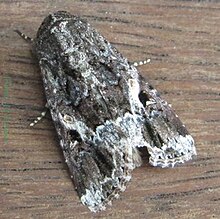Spodoptera mauritia
| Lawn armyworm | |
|---|---|

| |
| Scientific classification | |
| Domain: | Eukaryota |
| Kingdom: | Animalia |
| Phylum: | Arthropoda |
| Class: | Insecta |
| Order: | Lepidoptera |
| Superfamily: | Noctuoidea |
| Family: | Noctuidae |
| Genus: | Spodoptera |
| Species: | S. mauritia
|
| Binomial name | |
| Spodoptera mauritia (Boisduval, 1833)
| |
| Synonyms | |
| |
Spodoptera mauritia, the lawn armyworm or paddy swarming caterpillar, is a moth of the family Noctuidae. The species was first described by Jean Baptiste Boisduval in 1833. Able to eat many types of food, it is a major pest throughout the world.[1]
Distribution
It is widespread from the Red Sea to India, Myanmar, Sri Lanka, Malaya to Australia and widespread in the Pacific Islands, including the Solomons, New Hebrides, Fiji, Samoa, Hawaii, the Society Islands, Austral Islands, Marquesas and Marshall Islands.[2]
Description
The wingspan is about 40 mm. It is dark grey brown with a rusty tinge on its body. The abdomen is fuscous. Forewings with sub-basal, antemedial and postmedial double waved lines indistinct. The orbicular small and ochreous, whereas reniform blackish. Submarginal line whitish and irregularly waved. There is a white patch often can be seen between orbicular and reniform and a dark patch on the central marginal area. Hindwings opalescent and semi-hyaline white, with a dark marginal line.[3][4]
Ecology
The larvae feed on various grasses, including rice,[5] wheat, Cynodon, Pennisetum clandestinum, Sorghum bicolor, Oryza sativa, and trees such as Casuarina equisetifolia. They are considered one of the major international agricultural pests on crops and pastures.[6] Unlike other insects, armyworm caterpillars of their sixth instar do not excrete uric acid, instead they excrete urea as nitrogenous wastes.[7]
Damage and control
Plants attacked by caterpillars have skeletonized leaves, shot holes, and dieback stems. Commonly the entire paddy crop dies within few days due to swarming attack. Hand picking and other mechanical methods are used to reduce infection. Adults can be eliminated by introducing bolas spiders to the fields. This spider has the ability to spray a pheromone similar to the female moth, to attract male moths. The nematode Steinernema carpocapsae and usage of viruses like Nucleopolyhedrovirus are also effective.[8] Moths traps like wing traps and unitraps can also used to collect adults.[9]
Legacy
- In 1969, small outbreaks of less than 200 acres have been reported in the Sabah region of Malaysia, but in 6,000 square miles of outbreak was recorded from Sarawak. These attacks vanished 20% of total rice production in Malaysia.
- In 1981, paddy nurseries near marshy areas were severely affected by armyworm in Indonesia. This induced transplanting programs throughout the country and re-sowing of seedlings into the field highly susceptible to the attack.
- In 1983, nursery beds were devastated by the caterpillars, reduced the total rice production.
- In Sri Lanka, the heavy outbreaks were recorded twice from the country, first in 1904 and then in 1920, where Jaffna paddy cultivations were destroyed by the caterpillars.[10]
- An outbreak of armyworm, Spodoptera mauritia has been reported in Dibrugarh district of Assam, India during Kharif, 2012 <http://dx.doi.org/10.5958/0974-8172.2018.00225.0>
- The outbreak of Rice Swarming Caterpillar during Kharif, 2016 in Assam has been considered as one of the most devastating outbreaks in the state of Assam, India with an infestation in more than 34,650 ha area of rice across 28 districts.<http://dx.doi.org/10.5958/0974-8172.2018.00271.7>
- An outbreak in 2016 has reportedly damaged more than 17,418 hectares of cropland across 10 districts in Assam, India.
Subspecies
- S. m. mauritia (Indian Ocean)
- S. m. acronyctoides Guenée, 1852 (Oriental tropics, Australia, Pacific tropics, Japan)
See also
- African armyworm (Spodoptera exempta)
References
- ^ "Spodoptera mauritia, (Boisduval, 1833)". African Moths. Retrieved 3 August 2016.
- ^ "Spodoptera mauritia (paddy swarming caterpillar)". CABI. Retrieved 3 August 2016.
- ^ Hampson, G. F. (1894). The Fauna of British India, Including Ceylon and Burma: Moths Volume II. Vol. Moths - Vol. II. Taylor and Francis – via Biodiversity Heritage Library.
- ^ Holloway, Jeremy Daniel. "Spodoptera mauritia Boisduval". The Moths of Borneo. Retrieved 3 August 2016.
- ^ Saritha Pujari (October 28, 2015). "Rice Swarming Caterpillar (Spodoptera mauritia): Life Cycle, Nature and Control". Yourarticlelibrary.com. Retrieved 2015-11-29.
- ^ "Lawn Armyworm Facts". Australian Wildlife. Retrieved 3 August 2016.
- ^ Lazar, KV; Mohamed, UV (1979). "The excretion of urea by the larvae of Spodoptera mauritia Boisd. (Noctuidae: Lepidoptera) during development". Experientia. 35 (11): 1468. doi:10.1007/bf01962789. PMID 510484. S2CID 36495479.
- ^ Herbison-Evans, Don & Crossley, Stella (27 April 2013). "Spodoptera mauritia (Boisduval, 1833) Lawn Armyworm". Australian Caterpillars and their Butterflies and Moths. Retrieved 23 July 2018.
- ^ "Spodoptera mauritia". ChemTica. Retrieved 3 August 2016.
- ^ "Armyworm (Spodoptera mauritia acronyctoides)". Plantwise.org. Retrieved 2015-11-29.
External links
- Species info
- Australian Insects
- Zimmerman, Elwood C. (1958). Insects of Hawaii. Vol. 7 Macrolepidoptera. University of Hawaii Press, Honolulu. hdl:10125/7336.
- Rice swarming caterpillar (Spodoptera mauritia) and its management strategies
- Observations on the armyworm Spodoptera mauritia acronyctoides Gn. (Lep., Noctuidae) in Sarawak (Malaysian Borneo)
